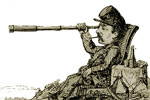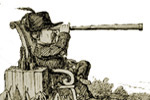THE SIGNAL CORPS.
JUNE 28, 1862 Harper's Weekly (Page 411)

|
THE SIGNAL CORPS OF THE UNITED STATES ARMY.
[-DRAWN BY MR. A. R. WAUD.]
|
|
The sketches will be particularly interesting at this time, when so much is heard of the Signal Corps. Major Myer, the Signal Officer of the Army and Chief of the Corps, was appointed from New York State, and entered the army in 1854. For many years he has worked in maturing his system, now the most complete ever organized; and when he received his commission as Major, indorsed by the highest military talent, and with authority to organize and instruct a class in the new code, it is a noticeable fact that his appointment was violently opposed by Jeff Davis.
With the means now at his disposal, Major Myer can have an uninterrupted line of signals established from the blockade of the Potomac to the extreme right of the army in six hours, each telescope sweeping the field of vision of those on the adjacent stations.
There are now signal officers detailed to the armies in Kentucky, in South Carolina, and with Burnside in North Carolina, and a party will soon be sent to the expeditions on the Mississippi. To prevent such accidents as have occurred by our troops firing into each other, Major Myer should, without a day's delay, be provided with the means of introducing the countersign signals throughout the whole army. The value and necessity of this system has been fully demonstrated in official reports.
The centre picture of the engraving represents an officer, accompanied by his flagman, at his station on the field of battle, his telescope slung to a tree for steadiness, and a star instead of a square on his flag, denoting that it has already been carried under fire in a manner to receive honorable mention for service on the battle-field. On the left is a party using torch signals. To the right, signaling at sea. Above, an officer is represented who has climbed a tree, by the assistance of a lariat, to get above the neighboring woods for observation. In the centre is a signal officer reconnoitring with his glass, his flag kept working out of sight of the enemy; and on the left platforms erected in trees to form a station. In the lower compartments an officer standing on a limber to get a view over the line of men moving at the double quick; a party running the gauntlet of the enemy's skirmishers to take up a position, and another party signaling on horseback, the large figures representing signalmen equipped and prepared to go upon duty.
In making these sketches I have received valuable assistance from Lieutenant N. Daniels, signal officer, for whose courtesy I here tender my acknowledgments.
- WAUD.
THE ARMY TELEGRAPH.
January 24, 1863 Harper's Weekly (Page 53)

|
THE ARMY TELEGRAPH—
SETTING UP THE WIRE DURING AN ACTION.
[SKETCHED BY MR. A. R. WAUD.]
|
|
 | 
|
THE ARMY TELEGRAPH—
THE OPERATOR AT WORK.
[SKETCHED BY MR. A. R. WAUD.]
| A SIGNAL STATION AT NIGHT.
[SKETCHED BY
MR. THEODORE R. DAVIS.]
|
|
ARMY TELEGRAM.
Of this important institution: "The army signal-telegraph has been so far perfected that in a few hours quite a large force can be in constant connection with head-quarters. This, while a battle is progressing, is a great convenience. The wire used is a copper one insulated,
raised on light poles, made expressly for the purpose, on convenient trees, or trailed along fences. The wire and the instrument can be easily carried in a cart, which as it proceeds unwinds the wire, and, when a connection is made, becomes the telegraph-office. Where the cart can not go the men carry the drum of wire by hand. In the picture the cart has come to a halt, and the signal-men are hastening along—some with the drum, while others with crow-bars make the holes for the poles, upon which it is rapidly raised.
"The machine is a simple one, worked by a handle, which is passed around a dial-plate marked with numerals and the alphabet. By stopping at the necessary letters a message is easily spelled out upon the instrument at the other end of the line, which repeats by a pointer every move on the dial-plate. The whole thing is so simple that any man able to read and write can work it with facility."
AN ARMY SIGNAL-STATION AT NIGHT.
The signal corps is one of the most hard-worked and deserving bodies in the service. All day and all night these signalmen are kept busy telegraphing news of movements and orders from one end of the army to the other, by the aid of their inscrutable signals.
[Entered according to Act of Congress, in the Year 1862, by Harper & Brothers, in the Clerk's Office of the District Court for the Southern District of New York.]




